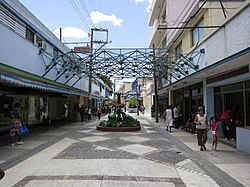Bayamo is the capital city of the Granma Province of Cuba and one of the largest cities in the Oriente region.
Bayamo | |
|---|---|
 The "Boulevard" of Bayamo | |
 Bayamo municipality (red) in Granma Province (yellow) and Cuba | |
| Coordinates: 20°22′54″N 76°38′34″W / 20.38167°N 76.64278°W | |
| Country | Cuba |
| Province | Granma |
| Established | November 15, 1513[1] |
| Incorporated | 1827 (city) |
| Government | |
| • President | Reydier Bernal Gómez |
| Area | |
| • Municipality | 918 km2 (354 sq mi) |
| Elevation | 55 m (180 ft) |
| Population (2022)[3] | |
| • Municipality | 236,826 |
| • Density | 260/km2 (670/sq mi) |
| • Urban | 169,209 |
| • Rural | 67,617 |
| Time zone | UTC-5 (EST) |
| Postal code | 85100 |
| Area code | +53 23 |
| Vehicle registration | G |
| Website | https://www.bayamo.gob.cu/es/ |

Overview
editThe community of Bayamo lies on a plain by the Bayamo River. It is affected by the violent Bayamo wind.
One of the most important education institutions in the province is the University of Granma.
History
editEstablished in 1513, Bayamo was the second of seven cities founded by Diego Velázquez de Cuéllar.[4] Francisco Iznaga,[5] a Basque landowner in the western portion of Cuba during the first 30 years of the colonization of Cuba, was elected mayor in 1540. Iznaga was the originator of a powerful lineage that finally settled in Trinidad, where the Torre Iznaga (Iznaga Tower) is. His descendants fought for the independence of Cuba, from 1820 to 1900.
During much of the 16th century it was one of the most important agricultural and commercial settlements of the island. Its inland situation gave it relative security against the pirates who infested West Indian seas, and the misfortunes of Santiago were the fortunes of Bayamo. Down the Cauto River, then open to the sea for vessels of 200 tons, and through Manzanillo, Bayamo drove a thriving contraband trade that made it the leading town of Cuba at the opening of the 17th century.[4]
A tremendous flood, in 1616, choked the Cauto with trees and wrecked vessels, cutting it off from direct access to the sea; but through Manzanillo it continued a great clandestine traffic with Curaçao, Jamaica, and other foreign islands throughout the 17th and 18th centuries. Bayamo was then surrounded by fine plantations.[4]
In 1827 it acquired the status of city. In the war of 1868–1878 it was an insurgent stronghold. One of the most desperate conflicts of the war was fought nearby, and it was nearly destroyed by the opposing parties.[4]
Demographics
editIn 2022, the municipality of Bayamo had a population of 236,826.[3] With a total area of 918 km2 (354 sq mi),[2] it has a population density of 242.0/km2 (627/sq mi). The urban population was 169,209.[6]
Transportation
editBayamo is an under-recognized world leader in sustainable transportation. Per a UN study only about 15% of commuters rely on motorized transport and almost three times as many (39%) rely on about 500 licensed horse-drawn carriages generally following fixed routes. The rest of the non-pedestrian traffic is bicycle and bicycle taxi.[7][8]
Carlos Manuel de Céspedes Airport satisfies the city's commercial aviation needs; it has had service to Havana on Cubana Airlines.
Notable residents
edit- Francisco Vicente Aguilera (1821–1877), revolutionary
- Ricardo Villaverde (1908–1999), surgeon and businessman
- Conrado Roblejo Aguilera (born 1966), doctor
- José Antonio Cedeño (born 1939), artist
- Carlos Manuel de Céspedes (1819–1874), revolutionary
- Perucho Figueredo (1818–1870), composer of the Cuban national anthem
- Pablo Milanés (1943–2022), singer
- Tomás Estrada Palma (1832–1908), first president of Cuba
- Felo Ramírez (1923–2017), radio presenter
- Rolando Uríos (born 1971), handball player
- Alexis Pantoja Perez (born 1969), painter
- Sigmund Sobolewski (1923–2017), Polish Holocaust survivor
- Sergio Pérez Barrero (Born 1953), Psychiatrist.
See also
edit- La Bayamesa, Cuban national anthem
References
edit- ^ Guije.com. "Bayamo" (in Spanish). Archived from the original on 13 October 2007. Retrieved 2007-10-06.
- ^ a b Statoids (July 2003). "Municipios of Cuba". Archived from the original on 12 October 2007. Retrieved 2007-10-06.
- ^ a b "Cuba: Administrative Division (Provinces and Municipalities) - Population Statistics, Charts and Map". www.citypopulation.de. Retrieved 2024-02-03.
- ^ a b c d One or more of the preceding sentences incorporates text from a publication now in the public domain: Chisholm, Hugh, ed. (1911). "Bayamo". Encyclopædia Britannica. Vol. 3 (11th ed.). Cambridge University Press. pp. 553–554.
- ^ Jorge Iznaga. FRANCISCO IZNAGA Iznaga Genealogy (IZNAGA - 1420 - Present), Retrieved 5 December 2012.
- ^ "Bayamo (Municipality, Cuba) - Population Statistics, Charts, Map and Location". www.citypopulation.de. Retrieved 2024-02-03.
- ^ "Getting the carriages out, Cuban-style". UN-HABITAT. 2004-07-20. Archived from the original on 2017-07-31. Retrieved 2017-07-31.
- ^ Jon Petrie. "Bayamo, an unacknowledged leader in horse dependent/ ecological transport". Lonely Planet. Archived from the original on 2017-07-31. Retrieved 2017-07-31.
External links
editMedia related to Bayamo at Wikimedia Commons

